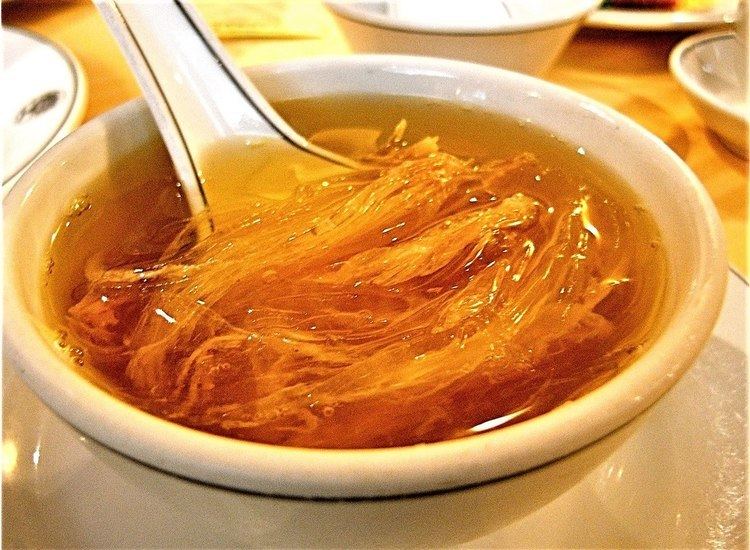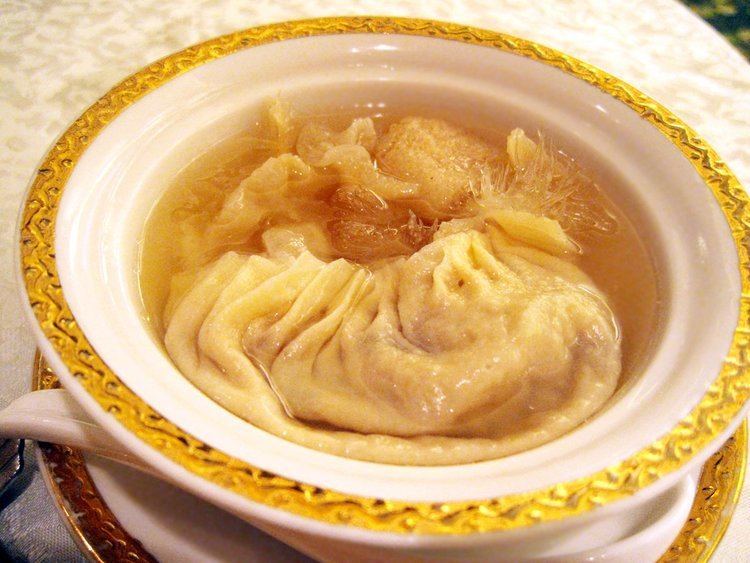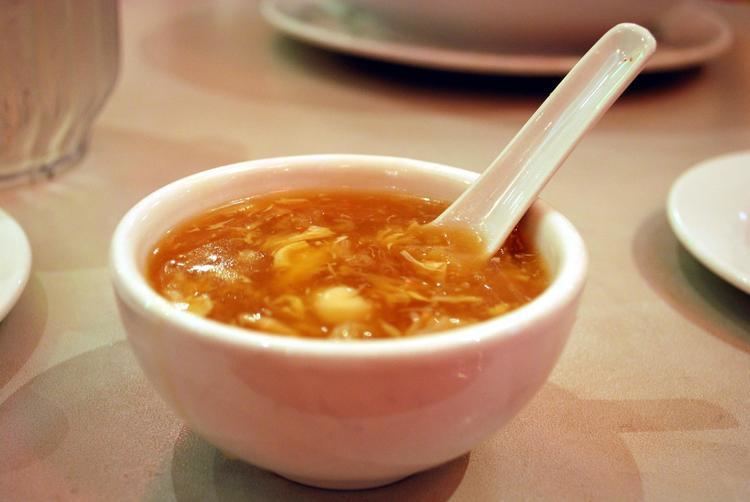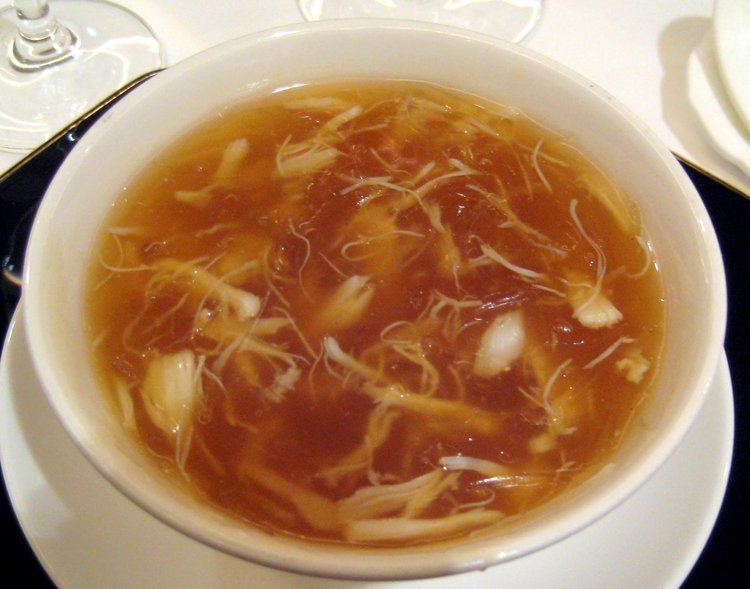Main ingredients Shark fins, broth | ||
 | ||
Similar Shark meat, Blue shark, Sea cucumber as food | ||
Gordon ramsay eats shark fin soup for the first time
Shark fin soup (or shark's fin soup) is a traditional soup or stewed item of Chinese cuisine and Vietnamese cuisine served at special occasions such as weddings and banquets, or as a luxury item in Chinese culture. The shark fins provide texture, while the taste comes from the other soup ingredients. The soup originated centuries ago during the Ming dynasty. Demand for the soup has increased as income levels of Chinese communities worldwide have risen. International concerns over the sustainability and welfare of sharks have impacted consumption and availability of the soup. Consumption reduced by 50-70% in China between 2011 and 2013.
Contents
- Gordon ramsay eats shark fin soup for the first time
- Gordon eats shark fin soup in taipei gordon ramsay
- History
- Preparation
- Taste
- Health impact
- Demand
- Environmental concerns
- Campaigns
- Alternatives
- References

Gordon eats shark fin soup in taipei gordon ramsay
History

Shark fin soup dates back to Ming dynasty China and is considered by Chinese as one of the eight treasured foods from the sea. The popularity of shark fin soup rose in the late 18th and early 19th centuries as standards of living began to improve. The delicacy was coveted by everyone from commoners to the emperors because it was rare and delicious only after a complicated and elaborate preparation. The Qing dynasty manual of cuisine, the Suiyuan shidan, indicated that the shark fin was eaten as soup, stew, and even as a stir-fry but in all cases the successfully prepared fin was enjoyed for its smooth and supple texture.

Holding both culinary and symbolic significance, the dish is popular at occasions such as weddings, banquets, and important business deals. It symbolizes wealth, power, prestige, and honor. This staple of gourmet Chinese cuisine is believed to be a show of respect, honor, and appreciation to the guests.
Preparation

Genuine shark fin soup or stew is made with shark fins obtained from any of a variety of shark species. Raw shark fins are processed by first removing the skin and denticles, then trimming them to shape and bleaching to a more desirable colour.
There are two types of the dried form, cooked/skinned (shredded) and raw/unskinned which requires more preparation. Both need to be softened before they can be used to prepare soup.
Sharks' fins are sold in many forms: dried, cooked, wet and frozen. Canned ready-to-eat shark fin soup is also available in Asian markets.
Taste
In shark fin soup, the fins themselves are virtually tasteless. The taste comes from the soup, while the fins are valued for their texture. It has a "chewy, sinewy, stringy" texture. Krista Mahr of Time called it "somewhere between chewy and crunchy." Dave Lieberman of OC Weekly wrote that it is a "snappy, gelatinous texture". Most westerners' reaction to eating shark fin for the first time is that it has almost no taste. However, the fin is used to provide the soup's unique texture rather than to add any flavor.
Health impact
Shark fins were believed in Chinese culture to have properties boosting sexual potency, enhancing skin quality, increasing qi or energy, preventing heart disease, and lowering cholesterol. In traditional Chinese medicine, shark fins were believed to help in areas of rejuvenation, appetite enhancement, and blood nourishment and to be beneficial to vital energy, kidneys, lungs, bones, and many other parts of the body. There is no scientific evidence that shark fins can be used to treat any medical condition.
Vitamin content of typical shark fin soup is much less than that of typical vegetable soup, containing almost no vitamin A. However, it contains slightly more iron, zinc, riboflavin, and phosphorus than normal vegetable soup.
There are claims that shark fins prevent cancer; however, there is no scientific evidence, and one study found shark cartilage to be of no value in cancer treatment.
WildAid, a wildlife non-governmental organization, warned that eating too much shark fin can cause sterility in men. It is known that larger fish such as shark, tuna, and swordfish contain high levels of the element mercury and methylmercury salts For soon-to-be-pregnant women, pregnant women, nursing mothers and young children, the United States Food and Drug administration has advised them to avoid consumption of fish high in mercury.
Demand
Shark fins are imported in massive amounts by Vietnam.
Shark fin soup is a popular delicacy in China, and is eaten in Chinese restaurants around the world. Peter Knights, executive director of WildAid, said in 2001 that the shark fin trade more than doubled in the prior 15 years.
A survey carried out in China in 2006 by WildAid and the Chinese Wildlife Conservation Association found that 35% of participants said they had consumed shark fin soup in the last year, while 83% of participants in an online survey conducted by the World Wide Fund for Nature said that they had consumed shark fin soup at some time.
In Hong Kong restaurants, where the market has traditionally been strong, demand from Hong Kong natives had reportedly dropped in 2006, but this was more than balanced by an increase in demand from the Chinese mainland, as the economic growth of China has put this expensive delicacy within the reach of a growing middle class.
Based on information gathered from the Hong Kong trade in fins, the market was estimated in 2004 to be growing by 5% a year. Consumption of shark fin soup has risen dramatically with the middle class becoming more affluent, as Chinese communities around the world enjoy increasing income levels. The high price of the soup means it is often used as a way to impress guests or at celebrations; 58 percent of those questioned in the WWF survey said they ate the soup at a celebration or gathering.
By late 2013, however, a report in The Washington Post indicated that shark fin soup was no longer seen as fashionable in China. The movement against shark fin soup began in 2006, when WildAid enlisted Chinese basketball star Yao Ming as the front person for a public relations campaign against the dish. The campaign was taken up by a coalition of Chinese businessmen, celebrities, and students, and began bearing fruit in 2012, when China passed a ban on shark fin imports. In January 2013, China Daily reported that officials in Zhejiang province found that many shark fin soup restaurants were selling artificial shark fins, and that one-third of the samples that the officials had obtained contained dangerous amounts of cadmium and methylmercury. Within two months of the China Daily report, China ordered officials throughout the country to stop serving dishes made from protected wildlife at official banquets, and in September, the Hong Kong government issued a similar order. According to WildAid, consumption of shark fin soup in China has dropped by 50 to 70 percent since 2011. China's commerce ministry indicated that consumption of shark fin soup during the 2013 Spring Break holiday had decreased by 70 percent from 2012, and Hong Kong industry groups reported that shark fin imports were down by 20 to 30 percent from 2012. Also, anecdotal evidence points to a worldwide drop in shark fin prices and a move away from shark fishing in parts of Africa.
Environmental concerns
Shark fins used in the soup are the cartilaginous dorsal, pectoral and caudal fins. Fins are sometimes harvested by a process known as shark finning. The person harvesting the fins often leaves the shark to die in the ocean after having cut the fins off. This poses a major threat to the world's shark populations.
Some groups, such as Fins Attached, Shark Savers, IUCN, Shark Angels, Shark Whisperer and the Sea Shepherd Conservation Society, discourage the consumption of the soup due to concerns with the world’s shark population and how inhumanely sharks are finned alive and tossed back into the ocean, unable to swim, hunt or survive. The prevalence of shark finning and the sustainability of sharks are both debated. Some feel banning the dish is offensive Major hotel operators such as The Peninsula Hotels and Shangri-La Hotels and Resorts stopped serving shark fin soup in the interest of offering sustainable seafood. The three largest supermarket chains in Singapore—Cold Storage, NTUC FairPrice and Carrefour—have stopped selling shark fins while also citing sustainability concerns. Hong Kong Disneyland dropped the soup from its menu after it could not find a sustainable source. The University of Hong Kong banned serving shark fin soup, hoping "to give a lead which others in Hong Kong will follow".
Malaysia's Natural Resources and Environment Ministry banned shark fin soup from official functions in a commitment to the Malaysian Nature Society to conserve the shark species. In the United States, Hawaii, Washington, Oregon, California, Guam, and the Commonwealth of the Northern Mariana Islands have banned the sale and possession of shark fins, effectively eliminating the availability of the soup. Illinois has become the fifth state to implement a ban on shark fin trade, the first non-Pacific state. In the past, Illinois has been a large importer of shark fins. In 2011, U.S. President Barack Obama signed the Shark Conservation Act, closing loopholes used to obtain shark fins. In October 2011, California governor Jerry Brown, citing the cruelty of finning and potential threats to the environment and commercial fishing, signed Assembly Bill 376, banning the possession and sale of detached shark fins. Opponents charged the ban was discriminatory against Chinese, the main consumers of the shark fin soup, when federal laws already banned the practice of finning. Whole sharks would still be legally fished, but the fins could no longer be sold. A lawsuit has been filed in United States District Court for the Northern District of California by Chinese American groups seeking to overturn the ban. In Canada, the Vancouver city council has decided to work towards creating some sort of ban to preserve the shark species. Toronto, Canada’s largest city, joined other municipalities like Brantford and Mississauga in adopting a shark fin ban on 13 October 2011. Calgary, Alberta, joined other Canadian cities in banning shark fin soup on 16 July 2012 . On 2 July 2012, China State Council of the People's Republic of China declared that sharks fin soup can no longer be served at official banquets. This ban may take up to three years to take effect because it is such a social dish in Chinese culture.
Campaigns
The marine conservation organization Bite-Back has campaigned against the sale of shark fin soup in Britain. On the back of its campaigning, the London-based Michelin-starred Chinese restaurant Hakkasan agreed to stop selling the controversial soup, while other high-profile names such as Gordon Ramsay, Hugh Fearnley-Whittingstall, and Charles Clover, author of The End of the Line: How Overfishing Is Changing the World and What We Eat, have lent their support to the charity's 'Hacked Off' campaign.
Alternatives
Substitutes for shark fin exist, commonly known as "mock shark's fin". Mock shark's fin was first used in Hong Kong during the 1970s. From the 1990s onward, mock shark’s fin became popular in many restaurants throughout China. Products can be made from various ingredients, primarily gelatin or the Sharkfin melon. An alternative uses soy. A Japanese company uses pork gelatin. A popular, low-cost "imitation shark fin soup" (zh:碗仔翅) made using vermicelli is widely available in Asia. They can also be made from cellophane noodles or fensi. Konjac can be a vegan alternative for shark fins. Other varieties included chicken breast, jinhua ham, and pig's skin. A Taiwanese manufacturer's recipe for imitation shark fin contains water, gelatin, alginic acid, sugar, casein, and triolein to imitate real shark fin's chewy, gelatinous texture. Currently, imitation shark fins, konjac, and other alternatives can be purchased in preserved form from local supermarkets and convenience stores.
